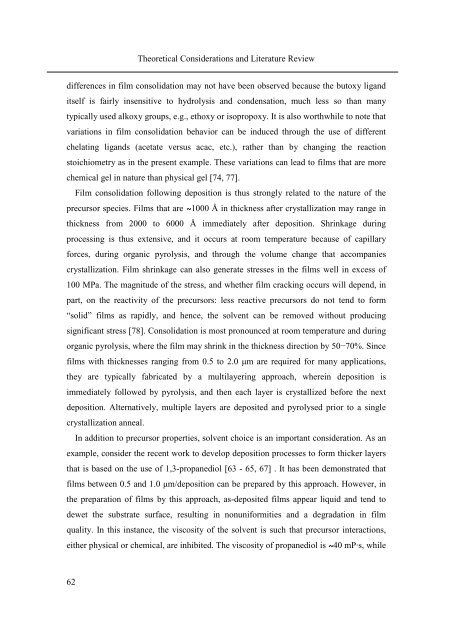PhD Thesis Arne Lüker final version V4 - Cranfield University
PhD Thesis Arne Lüker final version V4 - Cranfield University
PhD Thesis Arne Lüker final version V4 - Cranfield University
Create successful ePaper yourself
Turn your PDF publications into a flip-book with our unique Google optimized e-Paper software.
62<br />
Theoretical Considerations and Literature Review<br />
differences in film consolidation may not have been observed because the butoxy ligand<br />
itself is fairly insensitive to hydrolysis and condensation, much less so than many<br />
typically used alkoxy groups, e.g., ethoxy or isopropoxy. It is also worthwhile to note that<br />
variations in film consolidation behavior can be induced through the use of different<br />
chelating ligands (acetate versus acac, etc.), rather than by changing the reaction<br />
stoichiometry as in the present example. These variations can lead to films that are more<br />
chemical gel in nature than physical gel [74, 77].<br />
Film consolidation following deposition is thus strongly related to the nature of the<br />
precursor species. Films that are 1000 Å in thickness after crystallization may range in<br />
thickness from 2000 to 6000 Å immediately after deposition. Shrinkage during<br />
processing is thus extensive, and it occurs at room temperature because of capillary<br />
forces, during organic pyrolysis, and through the volume change that accompanies<br />
crystallization. Film shrinkage can also generate stresses in the films well in excess of<br />
100 MPa. The magnitude of the stress, and whether film cracking occurs will depend, in<br />
part, on the reactivity of the precursors: less reactive precursors do not tend to form<br />
“solid” films as rapidly, and hence, the solvent can be removed without producing<br />
significant stress [78]. Consolidation is most pronounced at room temperature and during<br />
organic pyrolysis, where the film may shrink in the thickness direction by 50−70%. Since<br />
films with thicknesses ranging from 0.5 to 2.0 µm are required for many applications,<br />
they are typically fabricated by a multilayering approach, wherein deposition is<br />
immediately followed by pyrolysis, and then each layer is crystallized before the next<br />
deposition. Alternatively, multiple layers are deposited and pyrolysed prior to a single<br />
crystallization anneal.<br />
In addition to precursor properties, solvent choice is an important consideration. As an<br />
example, consider the recent work to develop deposition processes to form thicker layers<br />
that is based on the use of 1,3-propanediol [63 - 65, 67] . It has been demonstrated that<br />
films between 0.5 and 1.0 µm/deposition can be prepared by this approach. However, in<br />
the preparation of films by this approach, as-deposited films appear liquid and tend to<br />
dewet the substrate surface, resulting in nonuniformities and a degradation in film<br />
quality. In this instance, the viscosity of the solvent is such that precursor interactions,<br />
either physical or chemical, are inhibited. The viscosity of propanediol is 40 mP·s, while

















